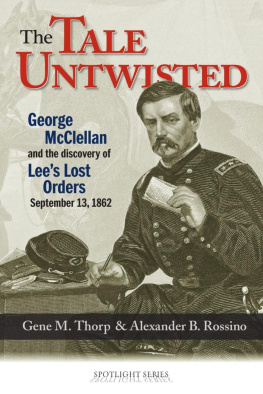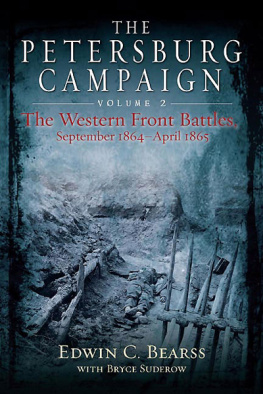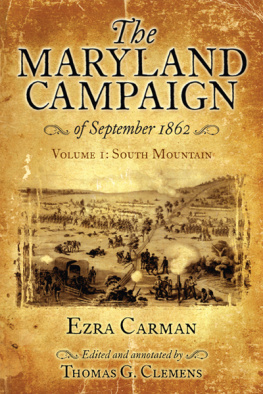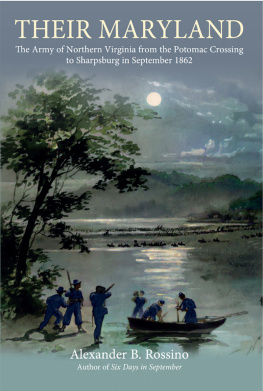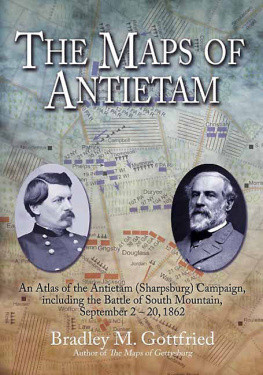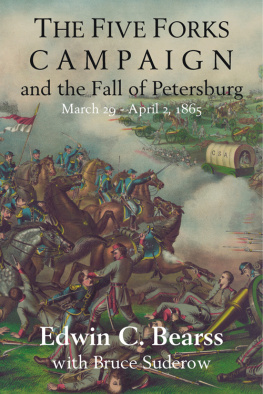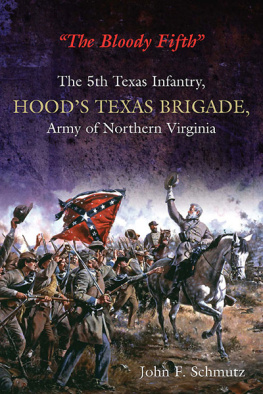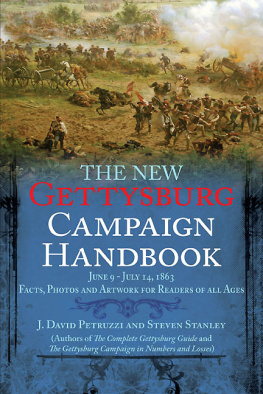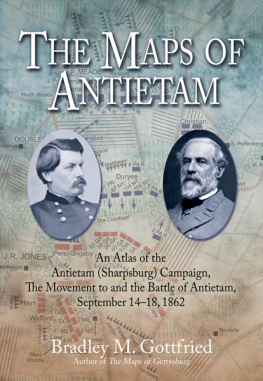
Also by Russel H. Beatie
Army of the Potomac
VOLUME I
Birth of Command
November 1860-September 1861
Army of the Potomac
VOLUME II
McClellan Takes Command
September 1861-February 1862
Road to Manassas
The Growth of Union Command in the Eastern Theater
from the Fall of Fort Sumter to the First Battle of Bull Run

2007 by Russel H. Beatie
All rights reserved. No part of this publication may be reproduced, stored in a retrieval system, or transmitted, in any form or by any means, electronic, mechanical, photocopying, recording, or otherwise, without the prior written permission of the publisher. Printed in the United States of America. Any similarities between characters and real life occurrences are completely coincidental.
Cataloging-in-Publication Data is available from the Library of Congress.
ISBN 10: 1-932714-25-1
ISBN 13: 978-932714-25-8
eISBN 9781611210217
10 9 8 7 6 5 4 3 2 1
First Edition, First Printing

Published by
Savas Beatie LLC
521 Fifth Avenue, Suite 3400
New York, NY 10175
Phone: 610-853-9131
Editorial Offices:
Savas Beatie LLC
P.O. Box 4527
El Dorado Hills, CA 95762
Phone: 916-941-6896
(E-mail) editorial@savasbeatie.com
Savas Beatie titles are available at special discounts for bulk purchases in the United States by corporations, institutions, and other organizations. For more details, please contact Special Sales, P.O. Box 4527, El Dorado Hills, CA 95762. You may also e-mail us at sales@savasbeatie.com, or click over for a visit to our website at www.savasbeatie.com for additional information.
To my old preparatory school
THE HACKLEY SCHOOL
and its superb history faculty, the school having given me a full scholarship for five years and a remarkable start in life.
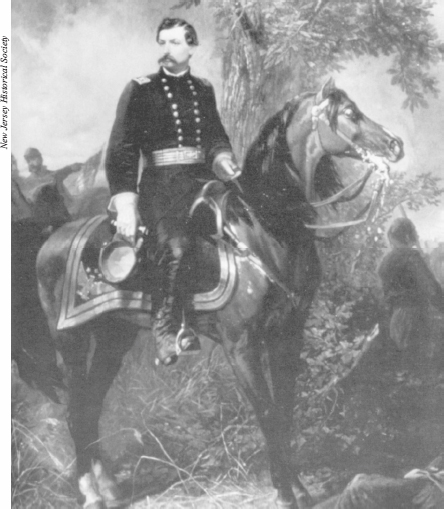
George B. McClellan
List of Illustrations
List of Maps
Preface
Many years ago, one of my history masters, a talented, highly intelligent, sarcastic man with a serious chip on his shoulder, told me I was wasting my time and talent by my interest in military historyespecially the American Civil War. In his opinion, it lacked the substance of the great European conflagrations; did not present the opportunities for sociological analysis, far more important as a causative factor than Carlyles Great Man theory of history; and was not susceptible to the subtle analysis of sources that was possible for other periods. Diplomatic and political history, he said, were far more important. None of his proselytizing, as it were, survived the test of time, overcame my bull-headed stubbornness, or proved to be correct.
What have I found as I plunge ever deeper into the sources for the Civil War? A mind-stretching magnitude of detail that gives life to the narrative, that allows a depth of analysis I never anticipated, and that permits a three-dimensional portrayal of the characters in the always fascinating plot. In fact, the information (like all large quantities of information about a single series of events) becomes susceptible to a bewildering number of interpretations and conclusions. The sources are so bountiful and diverse that they might almost allow a quantitative analysis like that found in William Robert Fogel Stanley L. Engermans Time on the Cross: The Economics of American Negro Slavery (Little Brown, 1974). Any writer who wishes to pretend to be a critical historian can start with his conclusion and find support for itno matter how bizarre or how unrealin the sources. Any number of General George B. McClellan bashers may be found among the creators of sources about the Army of the Potomac or the Union war in the East. But an equal number, equally impassioned, can be found among the letter-writers and diary-keepers who served in that army. A license for the historian to say, I want the story to come out this way? Or is it a challenge to treat the sources fairly and dispassionately, no matter how difficult the task or how unwanted the outcome?
For example, John Pope and Ambrose Burnside, who languished in the classical windowless room without lights, have been the beneficiaries of well-researched and well-written biographies in the last few years. For the benefit of the publisher of this volume, I challenged Eric Wittenberg, the keeper of the cavalry in the Eastern Theater, to write a biography of Philip H. Sheridan who, in spite of all his undesirable personal characteristics, deserves a good study for his many contributions to his country. I received a frank and thoroughly honest response from Wittenberg: I cant do it. I dislike him too much, and I could not treat him fairly.
This returns us to the source material that tells us nearly everything. To do justice to the events of the past, we must evaluate the sources and disregard those not entitled to belief. An excellent example of the extreme is General Alfred Pleasantons pure fabrication of the order he purportedly gave Major Peter Keenan of the Eighth Pennsylvania Cavalry to charge the victorious Rebel infantry of Stonewall Jacksons Corps at Chancellorsville on the afternoon of May 2, 1863. No such order was given or received by anyone. Uncertain about his place in the Army of the Potomac, Pleasonton wanted the credit for disrupting the Confederate flanking movement; Keenan and several of his officers obliged Pleasonton in his fabrication by cutting short a damned good game of cards and falling in the attack.
Another example, like Pleasontons fabrication comparatively easy to resolve, is the conflict among sources concerning Reconstruction in Mississippi. Who perpetrated violence during the elections resulting in the disenfranchisement of the blacks and restoration of the minority whites to political power in the middle 1870s, black men or white men? Various accounts, including testimony under oath, conflict sharply about who was armed, who inflicted injuries or death on the other side, and so forth.
The resolution of the more difficult issues of veracity created by sources more complex and less clear presents the researcher and student of the Civil War with many difficult opportunitiesand many chances to go wrong.
The first two volumes of this series merely wet our feet. In this one, we wade up to our knees in the real substance of controversy at a high level, controversy involving two of the most important men of the war: George McClellan as commanding general and Abraham Lincoln as civilian leader of his countrys military forces in time of war. Here, the sources and the criticism become profuse; the idea of a quantitative judgment becomes an absurdity. The sources must be assessed for accuracy, for veracity, and for completeness. Like most sources, none of them tells the entire story, and yet they must fit believably with all other sources. The authors opinion of both men will probably not square with any current or existing consensus, especially his view of Lincoln.
Acknowledgements
A universal, reliable finding aid for manuscripts about the American Civil War would make the life of any historian much easier. Of course, aids exist; but none fit the definition. The first was a Works Project Administration effort that, during the Depression, catalogued the holdings of many libraries and other repositories, but not all by any means. Many libraries and historical societies created and published their own calendars of manuscripts, and some focused on the Civil War alone. The multi-volume NUC-MUC, the next anthology, covered all periods and most major repositories with annual supplemental volumes, but it had a rather severe, exclusionary minimum number of pieces for inclusion as a listing: forty letters. Taking advantage of recent technological advances, many repositories have websites with descriptions of their collections and search capacity by name or subject matter. The last and probably the most valuable for the experienced student of the Civil War are the bibliographies in new works by an established person in the field. Those fortunate enough to know participants in the game and feel free to solicit help often learn the location of things known to exist; for example, the manuscripts of Charles C. Griffin, Charles Candler, H. E. Tremain, and others who served in positions that involved them in controversial events.


